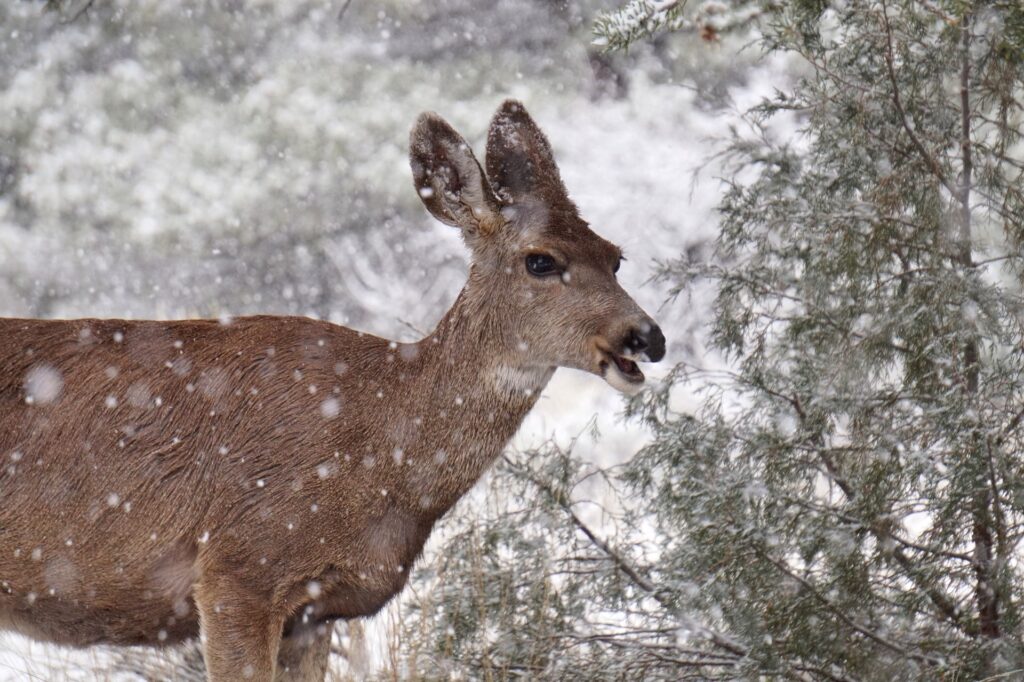FILE PHOTO: A mule deer browses in a late spring snowstorm at the Great Sand Dunes National Park. Photo by Mike Lewinski on Unsplash
LOGAN—Last year the Division of Wildlife Resources fed deer in an emergency situation because deep snow made it difficult for deer to find food in parts of Rich, Cache and Summit counties. This year’s winter has been different; the snow is not as deep and the cold has not been as bad as last year.

Mark Hadley, Northern Region Outreach Manager for the Division of Wildlife Resources, said up to now Utah’s big game have fared well this winter.
DWR Big Game Coordinator Dax Mangus provided some information from his statewide big game captures this past winter. They recently finished December capture efforts associated with their deer survival study where they checked over 900 deer across the state.
“We observed heavy, fat and healthy does, highest statewide average body fat levels observed in the last 10 years since we started this project,” he said. “We measured record high adult doe body fat percentages on the Cache, Morgan, Wasatch-Manti, Monroe and Pine Valley units.”
They observed great, above-average weights for fawns in central and southern Utah including the heaviest fawns seen since they started the project on Book Cliffs, Monroe, Pine Valley, and San Juan.
“Fawn weights were just average in Northern Utah, likely a carryover effect from last winter,” he said. “Compared to last year, statewide doe condition is up 2.4% body fat (27% increase from Dec 2022). Fawn weights averaged 1.5 pounds heavier in Dec 2023 compared to Dec 2022.”
Hersey said because of this year’s mild winter so far, with no considerable snow until January (much later than last year) and deer are in great condition.
“With the mild winter and great deer condition, we are optimistic that we will see high overwinter survival for both does and fawns,” he said.
Last year, DWR biologists, volunteer landowners and hunters from local conservation groups started feeding deer at 11 locations in the state in an emergency situation.
DWR biologists start monitoring the condition of the deer, as well as snow depths and winter temperatures, across Utah in early December.
These monitoring efforts include body condition and health assessments conducted during the big game captures via helicopter that take place each year from December to March. Biologists measure and record overall deer condition, body fat levels and fawn weights as the animals enter into the winter season.
In a report from last year, DWR asked people not to feed deer or any other wildlife.
“In the areas where we’re feeding, the vegetation that deer eat in the winter is completely covered by snow,” DWR Northern Region Wildlife Manager Jim Christensen said. “Deer will eat hay, but if that is their only source of feed during the winter they can have a very difficult time digesting it. We often find dead deer with stomachs filled with hay.”
DWR officials said they realize people want to help the deer, but they strongly discourage people from feeding hay or other things to deer. There are special circumstances that follow Division policies, involve trained professionals and utilize specialized feed.
They recommend the public not feed wildlife, due to safety concerns, among other things.

“Chronic wasting disease is fatal to deer that contract it, and it’s highly contagious,” Mangus said. “Congregating deer at a feeding location increases the chance that a deer with chronic wasting disease will pass it on to other deer. The short-term benefits of feeding do not outweigh the negative long-term consequences of spreading chronic wasting disease in a highly congregated deer population.”
Utah mule deer have evolved enough over time to survive harsh weather, and a few deer dying in years with severe weather is expected. The natural cycle can actually benefit a deer population by removing sick animals and older animals that aren’t contributing to the population through reproduction.

